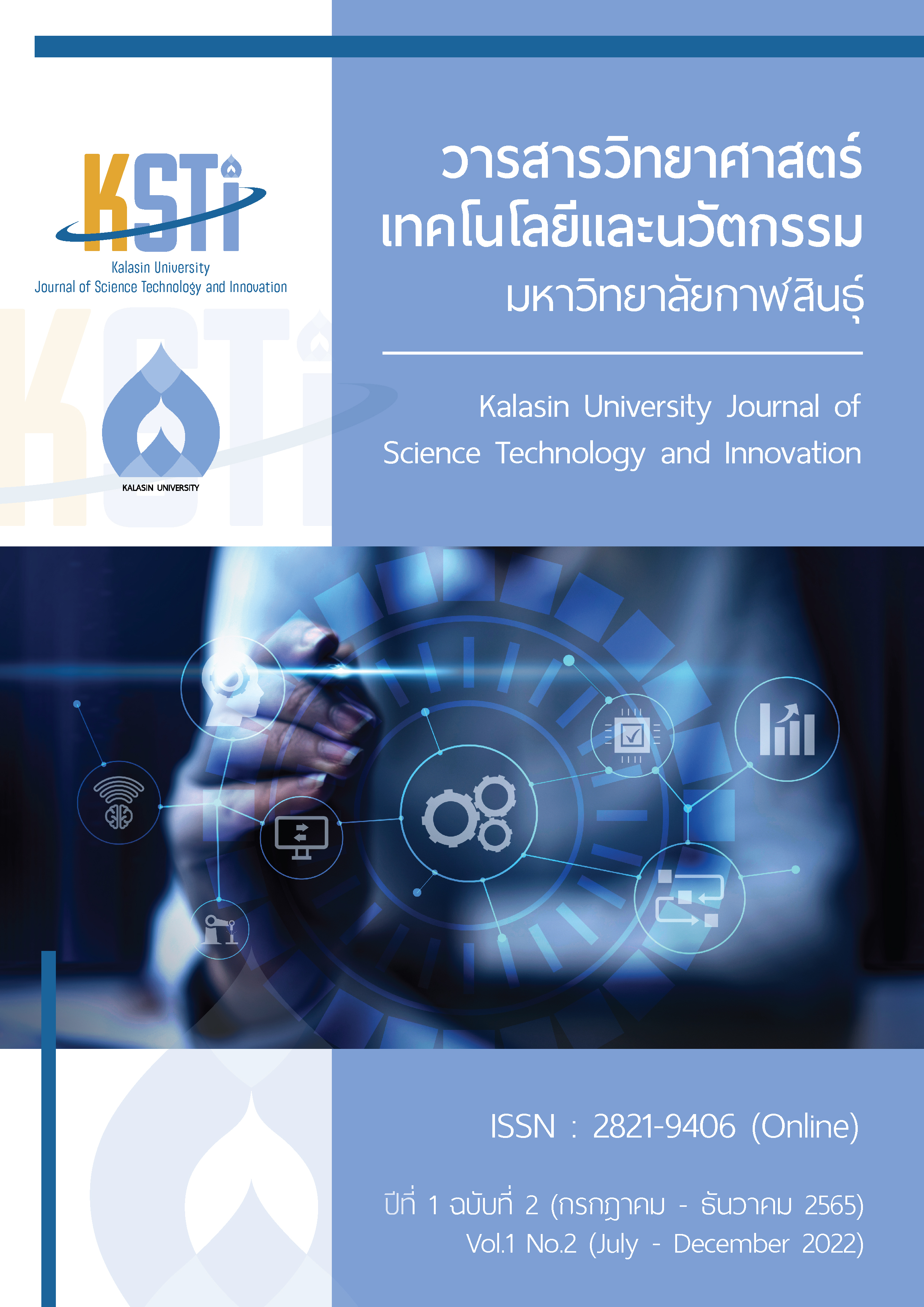ผลของวิธีการทำแห้งต่อคุณสมบัติทางเคมีกายภาพ และฤทธิ์การต้านอนุมูลอิสระของใบคะน้าเม็กซิโก
Main Article Content
บทคัดย่อ
งานวิจัยนี้มีวัตถุประสงค์เพื่อศึกษาวิธีการทำแห้ง 3 วิธี คือ การทำแห้งแบบถาด (tray drying) การทำแห้งแบบลูกกลิ้งคู่ (drum drying) และการทำแห้งแบบระเหิด (freeze drying) ที่มีผลต่อคุณสมบัติทางกายภาพ และเคมีและฤทธิ์การต้านอนุมูลอิสระของใบคะน้าเม็กซิโกผง พบว่า ใบคะน้าเม็กซิโกที่ผ่านการทำแห้งแบบระเหิดจะมีปริมาณความชื้นต่ำที่สุด มีค่าความสว่าง และค่าสีเขียวสูงสุด นอกจากนี้ ใบคะน้าเม็กซิโกที่ผ่านการทำแห้งแบบระเหิดมีปริมาณสารประกอบฟีนอลิก และปริมาณฟลาโวนอยด์สูงสุด รวมถึงมีฤทธิ์การต้านอนุมูลอิสระด้วยวิธี FRAP Assay สูงที่สุด เมื่อเปรียบเทียบกับการทำแห้งแบบถาด และการทำแห้งแบบลูกกลิ้ง อย่างไรก็ตาม วิธีการอบแห้งไม่มีผลต่อสารพฤกษเคมีในใบคะน้าเม็กซิโก ดังนั้น การทำแห้งแบบระเหิดจึงเป็นวิธีที่ดีที่สุดในการรักษาคุณภาพทางด้านกายภาพและเคมีของคะน้าเม็กซิโก
Downloads
Article Details

อนุญาตภายใต้เงื่อนไข Creative Commons Attribution-NonCommercial-NoDerivatives 4.0 International License.
เจ้าของลิขสิทธิ์ (สถาบันวิจัยและพัฒนา มหาวิทยาลัยกาฬสินธุ์) ผู้เขียน ตกลงว่าการทำสำเนาบทความหรือส่วนใดส่วนหนึ่งของบทความดังกล่าวในรูปแบบสิ่งพิมพ์หรืออิเล็กทรอนิกส์ตามที่ได้รับอนุญาต จะต้องระบุประกาศลิขสิทธิ์ตามที่กำหนดไว้ในวารสาร พร้อมทั้งอ้างอิงข้อมูลฉบับสมบูรณ์ของบทความที่ตีพิมพ์ในวารสารที่จัดทำโดย สถาบันวิจัยและพัฒนา มหาวิทยาลัยกาฬสินธุ์ อย่างครบถ้วนทุกครั้ง
เอกสารอ้างอิง
Jiménez-Arellanes MA, García-Martínez I, Rojas-Tomé S. Potencial biológico de especies medicinales del género Cnidoscolus (Euphorbiacea). Revista Mexicana de Ciencias Farmacéuticas [Internet]. 2014;45(4):1–6. Available from: https://www.redalyc.org/articulo.oa?id=57940028003
Padilla-Camberos E, Torres-Gonzalez OR, Sanchez-Hernandez IM, Diaz-Martinez NE, Hernandez-Perez OR, Flores-Fernandez JM. Anti-Inflammatory Activity of Cnidoscolus aconitifolius (Mill.) Ethyl Acetate Extract on Croton Oil-Induced Mouse Ear Edema. Applied Sciences [Internet]. 2021;11(20). Available from: https://www.mdpi.com/2076-3417/11/20/9697
Quintal Martínez JP, Segura Campos MR. Cnidoscolus Aconitifolius (Mill.) I.M. Johnst.: A Food Proposal Against Thromboembolic Diseases. Food Reviews International [Internet]. 2021 Jun 10;1–34. Available from: https://doi.org/10.1080/87559129.2021.1934002
Bautista-Robles V, Reyes G, Sánchez-Torres G, Parada-Luna J, Barrios-Gutiérrez J, Vázquez-Cerero D, et al. Cnidoscolus aconitifolius: therapeutic use and phytochemical properties. Literature review Cnidoscolus aconitifolius: usos terapéuticos y propiedades fitoquímicas. Revisión de la literatura. Rev Fac Med Univ Nac Colomb. 2020 Oct 1;68:446–52.
Buachoon N. Phytochemical Screening Antioxidant Activities α-Amylase and α-Glucosidase Inhibitory Activities of Cnidoscolus aconitifolius Extracts. Phranakhon Rajabhat Research Journal (Science and Technology). 2020;15(1):118–32.
Wiriyawattana P, Suwonsichon S, Suwonsichon T. Effects of drum drying on physical and antioxidant properties of riceberry flour. Agriculture and Natural Resources. 2018;52(5):445–50.
Ratti C. Hot air and freeze-drying of high-value foods: a review. J Food Eng. 2001;49(4):311–9.
Ayoola GA, Coker HA, Adesegun SA, Adepoju-Bello AA, Obaweya K, Ezennia EC, et al. Phytochemical screening and antioxidant activities of some selected medicinal plants used for malaria therapy in Southwestern Nigeria. Tropical Journal of Pharmaceutical Research. 2008;7(3):1019–24.
AOAC. Official method 925.10: Solids (total) and moisture in foodstuffs (air oven method). Official methods of analysis of the association of official analytical chemists. 2000;
Singleton VL, Rossi JA. Colorimetry of total phenolics with phosphomolybdic-phosphotungstic acid reagents. Am J Enol Vitic. 1965;16(3):144–58.
Zhishen J, Mengcheng T, Jianming W. The determination of flavonoid contents in mulberry and their scavenging effects on superoxide radicals. Food Chem. 1999;64(4):555–9.
Brand-Williams W, Cuvelier ME, Berset C. Use of a free radical method to evaluate antioxidant activity. LWT-Food science and Technology. 1995;28(1):25–30.
Re R, Pellegrini N, Proteggente A, Pannala A, Yang M, Rice-Evans C. Antioxidant activity applying an improved ABTS radical cation decolorization assay. Free Radic Biol Med. 1999;26(9–10):1231–7.
Benzie IFF, Strain JJ. [2] Ferric reducing/antioxidant power assay: direct measure of total antioxidant activity of biological fluids and modified version for simultaneous measurement of total antioxidant power and ascorbic acid concentration. In: Methods in enzymology. Elsevier; 1999. p. 15–27.
Seekhaw P, Chuaboonmee R, Surayot P, Chadpan S, Thurnkul N. Evaluation of Phytochemical Screening, Antioxidant and Antimicrobial Activities from Ethanolic Extracts of the Flacourtia indica (Burm.f.) Merr. Fruits. Journal of Applied Research on Science and Technology (JARST). 2020;19(1):124–36.
Boonnaum P, Kabae N, Hayeemasalaeh R, Marde W, Suwannarat P, Noipha K. Phytochemical Study, Total Phenolic, and Antioxidant Activity of Boesenbergia Pandurata Holtt Extract for Development of Paper Hand Soap. Research and Development Health System Journal. 2021;14(3):152–65.
Krokida MK, Tsami E, Maroulis ZB. KINETICS ON COLOR CHANGES DURING DRYING OF SOME FRUITS AND VEGETABLES. Drying Technology [Internet]. 1998 Jan 1;16(3–5):667–85. Available from: https://doi.org/10.1080/07373939808917429
Jokic S, Mujic I, Martinov M, Velić D, Bilic M, Lukinac J. Influence of Drying Procedure on Colour and Rehydration Characteristic of Wild Asparagus. Czech Journal of Food Sciences. 2009 Jan 1;27:171–7.
Guiné R, Barroca M. Effect of drying treatments on texture and color of vegetables (pumpkin and green pepper). Food and Bioproducts Processing - FOOD BIOPROD PROCESS. 2012 Jan 31;90.
Seremet (Ceclu) L, Botez E, Nistor OV, Andronoiu DG, Mocanu GD. Effect of different drying methods on moisture ratio and rehydration of pumpkin slices. Food Chem [Internet]. 2016;195:104–9. Available from: https://www.sciencedirect.com/science/article/pii/S0308814615005063
Afolabi I. Moisture Migration and Bulk Nutrients Interaction in a Drying Food Systems: A Review. Food Nutr Sci. 2014 Jan 1;5:692–714.
Rababah T, Aludatt M, Alhamad M, Al-Mahasneh M, Ereifej K, Andrade J, et al. Effects of drying process on total phenolics, antioxidant activity and flavonoid contents of common mediterranean herbs. International Journal of Agricultural and Biological Engineering. 2015 Jan 1;8:145–50.
Gao Y, Xia W, Shao P, Wu W, Chen H, Fang X, et al. Impact of thermal processing on dietary flavonoids. Curr Opin Food Sci [Internet]. 2022;48:1–10. Available from: https://www.sciencedirect.com/science/article/pii/S2214799322001175
Snoussi A, Essaidi I, ben Haj Koubaier H, Zrelli H, Alsafari I, Živoslav T, et al. Drying methodology effect on the phenolic content, antioxidant activity of Myrtus communis L. leaves ethanol extracts and soybean oil oxidative stability. BMC Chem [Internet]. 2021;15(1):1–11. Available from: https://doi.org/10.1186/s13065-021-00753-2
Złotek U, Gawlik-Dziki U, Dziki D, Świeca M, Nowak R, Martinez E. Influence of Drying Temperature on Phenolic Acids Composition and Antioxidant Activity of Sprouts and Leaves of White and Red Quinoa. Barreca D, editor. J Chem [Internet]. 2019;4:1–8. Available from: https://doi.org/10.1155/2019/7125169
Nguyen QV, Huyen B, Thi B, Tran MĐ, Nguyen MT, Doan MD, et al. Impact of Different Drying Temperatures on In Vitro Antioxidant and Antidiabetic Activities and Phenolic Compounds of Wild Guava Leaves Collected in the Central Highland of Vietnam. Nat Prod Commun [Internet]. 2022 Apr 1;17(4):1–10. Available from: https://doi.org/10.1177/1934578X221095349
Alide T, Wangila P, Kiprop A. Effect of cooking temperature and time on total phenolic content, total flavonoid content and total in vitro antioxidant activity of garlic. BMC Res Notes [Internet]. 2020;13(1):564. Available from: https://doi.org/10.1186/s13104-020-05404-8
Manok S, Limcharoen P. Investigating Antioxidant Activity by DPPH, ABTS and FRAP Assay and Total Phenolic Compounds of Herbal Extracts in Ya-Hom Thepphachit. Advanced Science. 2015;15:106–17.


